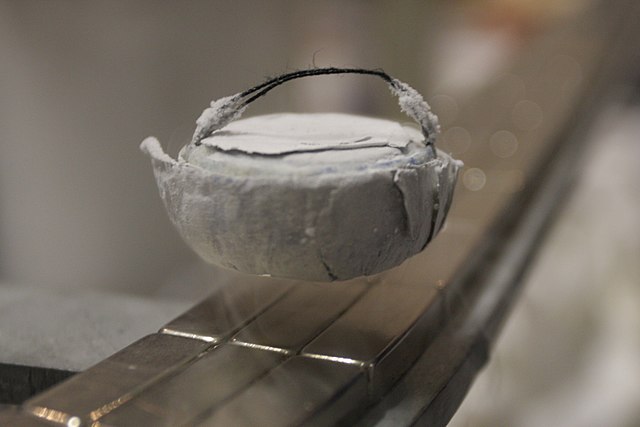
What is a superconductor? It is a state of matter for a material where there is zero resistance to electricity.
We need to start by looking at what electrical resistance is. Electrical resistance is, rather obviously, a resistance to the flow of electricity.
An electric current results when electrons flow from an area with a large number of electrons to an area with a low number of electrons. This difference is called the electric difference potential. Just like wind flows from an area of high pressure to an area of low pressure, electrons move in the same way. Electrons orbit around atoms, but when they are given enough energy, they can jump off their atom and move to another one. This is how electricity is transferred. Each electron jumps to the next atom, transferring its energy to an electron on that atom which jumps on and continues the transfer. When the electrons flow, they don’t move in a straight line. They are almost like balls on a pinball machine, bouncing off all of the pegs. In this case, the pegs are the nuclei of the atoms that make up the material that the electrons are moving through. Occasionally, the electrons hit a nuclei and each time they hit a nuclei, they release their energy as heat. Sometimes, such as with the heating element in a toaster, you want this heat because it can be used to cook toast, but most often you don’t. Resistance is also influenced by the size and the shape of the material the current is being passed through. An analogy of water through a pipe is often used. Water at the sides of the pipe flows more slowly than water in the middle because it is coming into contact with the pipe and friction produces resistance, slowing the water down. Water also flows more quickly through wide pipes than it does narrow ones and through straight pipes than through twisted ones. A longer pipe will have more resistance than a shorter pipe as well. All of these things are the same with electricity and can increase the resistance.
The molecules get in the way of the electrons and cause resistance, so it could be assumed that a denser material with more molecules would have more resistance than a less dense material, but this isn’t the case. Some dense materials, such as silver, have electrons that can more and transfer energy more easily than some less dense materials, such as wood.
So, what is a superconductor? A superconductor is a state where there is zero electrical resistance. To get electrons to move across a material requires energy, which is generated from burning oil, or sunlight, or other ways, and this energy is transferred across the material. Every time an electron hits a nuclei, its energy is lost as heat and the efficiency of the material goes down. If the power source is removed, the remaining power will be lost as heat until there is nothing left. Because a superconductor has zero resistance, the energy is never lost and will be transferred through the material forever. A superconductor has zero resistance and 100% efficiency. To achieve that, it has to be cooled down to the point where its atoms and electrons don’t move the way they do in normal materials. At low temperatures, almost to the point of absolute zero, which is -273.15 ℃, the atoms stop moving. All atoms vibrate at a different frequency, and this vibration means there is more chance that they will get in the way of electrons. With no vibration, that chance is reduced to almost zero. The second thing that happens is the movement of the electrons becomes very stable. At normal temperatures, the electrons bounce all over the place until they transfer their energy or hit the nucleus of an atom. In a superconductor, the electrons form pairs called Cooper pairs that spin at the same speed as each other, but in opposite directions. They move in sync with each other, avoiding the nuclei, and passing on the current without any loss.
Getting a material down to the temperatures required for a superconductor is very difficult and very expensive. Recent research has shown that some materials can become superconductors at -196℃, which is still pretty low but much easier to achieve and maintain than close to absolute zero. If this becomes possible and scalable, the possibilities are limitless. And this is what I learned today.
Image By Henry Mühlpfordt – Own work, CC BY-SA 3.0, https://commons.wikimedia.org/w/index.php?curid=9491383
Sources
https://www.physicsclassroom.com/class/circuits/Lesson-3/Resistance
https://www.livescience.com/superconductor
https://builtin.com/hardware/superconductor
https://telgurus.co.uk/what-causes-or-reduces-resistance-in-a-material
https://www.bbc.co.uk/bitesize/guides/zqk9v9q/revision/2
https://en.wikipedia.org/wiki/Electric_charge
https://www.britannica.com/story/why-are-some-metals-more-conductive-than-others
https://en.wikipedia.org/wiki/Electrical_resistance_and_conductance
